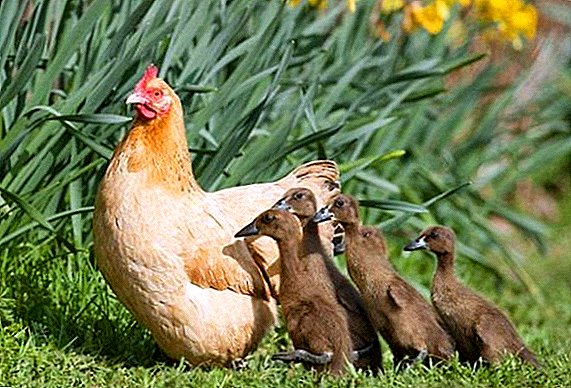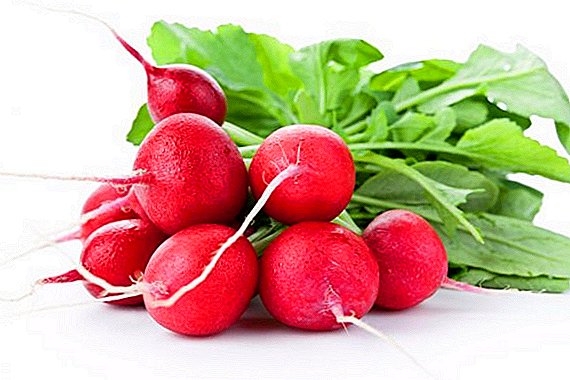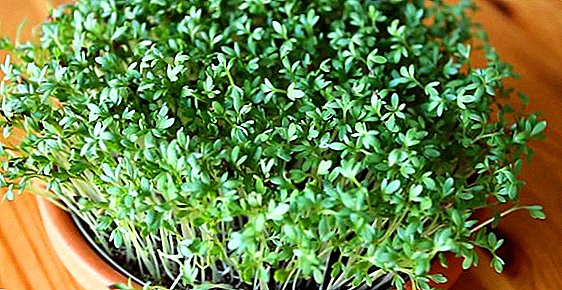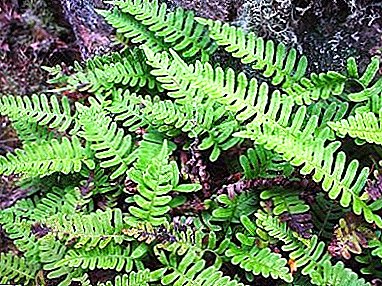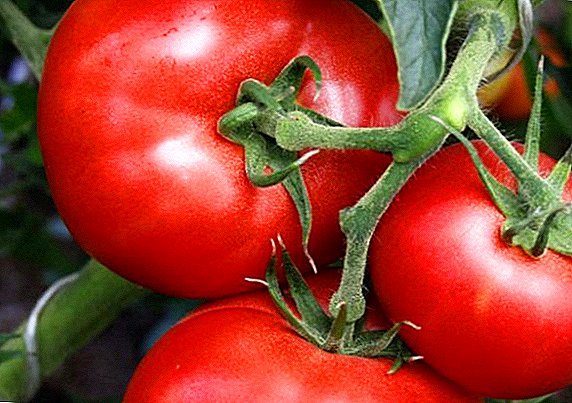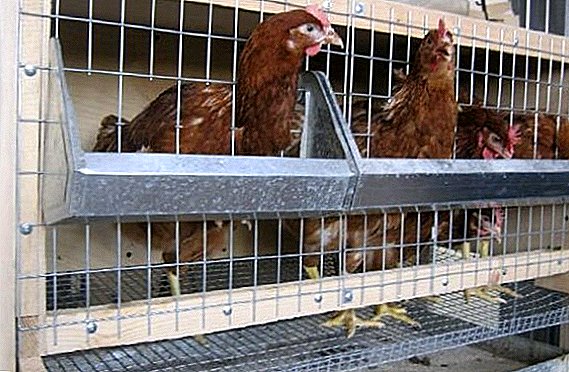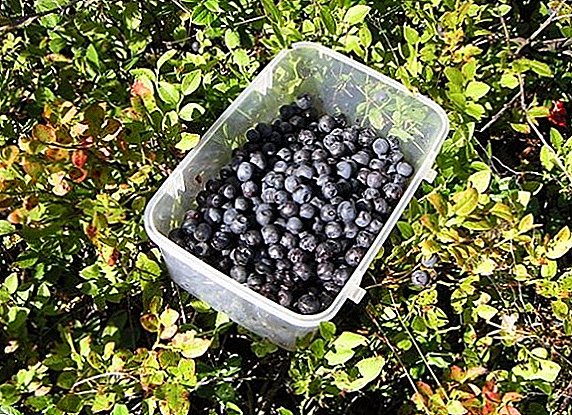 Blueberries are a very tasty, healthy and nutritious berry. She is happy to eat raw, add to yogurt, oatmeal and desserts, make jam, juice and other preparations. Some prefer to collect it in the forest, and experienced gardeners successfully grow bushes on their land. Everything about blueberries, growing and caring for it later in our article.
Blueberries are a very tasty, healthy and nutritious berry. She is happy to eat raw, add to yogurt, oatmeal and desserts, make jam, juice and other preparations. Some prefer to collect it in the forest, and experienced gardeners successfully grow bushes on their land. Everything about blueberries, growing and caring for it later in our article.
Recommendations for choosing planting material
The best material for planting are two or three-year bushes with a clod of earth on the roots, which must be damp before planting.
Tips for planting blueberries in the garden
Bilberry is a forest plant, therefore it is necessary for it to create similar conditions at home, during its planting and care. 
Optimum landing times
You can plant blueberries in autumn or spring. The best time for planting is considered to be October and November (beginning).
Choosing a place on the blueberry field
The natural place of growth of blueberries is pine forest, so for the cultivation of blueberries in the country need to ensure adequate moisture and acid reaction of the soil. Garden blueberries grow better in a sunny area, rather than in the shade, and excessive soil moisture is undesirable for it.
Important! The combination of blueberries, lingonberries, ericas and rhododendron in landscape design is used for arranging alpine gardens.
Preparatory work on the site
The usual garden soil for blueberries is not suitable, in unbecoming conditions, it will turn yellow and may soon die, so the soil must first be prepared. This should be done in advance: if you plan to land in October, then all measures must be made no later than September. For each bush we make a hole 1.5 mx 1.5 m in size and 0.6 m deep. If the soil is light, it is enough to put peat chips, kitchen cleanings, sawdust, chopped bark or rotted oak leaves in a ratio of 2: 1. Powdered sulfur (150-250 g per sq. M) acidifies the soil even more. In heavy soils add river sand. Before planting the soil in the pit should settle.
Did you know? Blueberry is a great honey plant. Blueberry honey is very fragrant, it has a pleasant taste and a reddish tinge.
Optimum landing pattern
If you want to plant blueberry bushes in one row, the distance between the bushes should be 1.5 m. For planting in two rows, leave 2.5 m between the bushes. Before planting blueberries, the roots of the seedlings need to be straightened and the soil loosened. In the prepared soil, we make a hole according to the size of the root, moisten it, plant a bush and cover it with soil. The earth around the plant needs to be compacted and watered.
Did you know? The biological name for bilberry is Vaccinium myrtillus. The generic name comes from the Latin word "cow" ("vacca"), because the leaves of some species are suitable for livestock feed, and specific - from the word "myrtus" ("myrtus") because of the similarity of blueberries with a small myrtle.
Rules of seasonal care for garden blueberries
When caring for garden blueberries are important measures such as watering, weeding, loosening the soil, mulching, pruning.
How to conduct watering
Blueberries need regular, but not too abundant watering. Excess moisture can cause diseases.
Weeding and loosening the soil
Blueberry roots are practically at the surface of the soil, so closer to the bush loosening should be done with extreme caution, to a small depth (about 3 cm).
The role of mulch
 Mulch helps to reduce the frequency of loosening, retain moisture in the soil, fight weeds, and in the summer does not allow the upper layer of the soil to overheat. It is best to put on the ground near the plant, without closing the root neck, a layer of sawdust 10 cm thick and slightly mix them with the soil. Another good option for mulch is shredded kitchen cleaning. With less impact, you can use straw and fallen leaves.
Mulch helps to reduce the frequency of loosening, retain moisture in the soil, fight weeds, and in the summer does not allow the upper layer of the soil to overheat. It is best to put on the ground near the plant, without closing the root neck, a layer of sawdust 10 cm thick and slightly mix them with the soil. Another good option for mulch is shredded kitchen cleaning. With less impact, you can use straw and fallen leaves.
How to conduct dressing
Blueberries will thank you for a generous harvest if you feed them properly. Organic fertilizer for bilberry garden can be manure, compost or peat chips. Every 2-3 years they are applied to the top layer of soil at the rate of 3-4 kg per square meter. From mineral fertilizers, superphosphate, ammonium superphosphate, and potassium magnesia are used. At low acidity of the soil (pH above 5.0), powdered sulfur (50–60 g) is added annually under each bush. With quality mulching, this procedure is optional.
Important! Every few years, it is advisable to check the reaction of the soil. This is done with the help of litmus paper: they impose a moist soil on it and wait for a color change. The optimal pH for blueberries is 3.8.
Literate pruning
Proper cultivation of blueberry garden is impossible without high-quality pruning, as the bushes greatly expand. Pruning is best done in early spring, when blueberries have not entered the stage of bud swelling. Late pruning during flowering can lead to lower yields. If you are transplanting bushes that are more than 3 years old, after planting, the branches should be cut to a height of 20 cm so that the plant can develop healthy young shoots. When the bush reaches the age of 3-4 years, it needs regular pruning. A healthy bush consists of 6-8 branches, all damaged, dry or diseased branches must be removed. Side shoots with buds are also removed, small berries form on them and ripen longer. Older bushes over the age of 15 years are recommended to carry out anti-aging pruning to a height of 20 cm. This measure will help to maintain yield. 
Did you know? In the Transcarpathian village of Guklyny there is the only monument of blueberries in Ukraine, or yafina, as they call it in these parts. The village is located among the valleys of the Borzhava mountain range, where there are large "blueberry fields".
Pest and disease protection
To prevent plants from pests and diseases, it is necessary to collect and burn fallen leaves, to mulch bushes regularly.
With the defeat of the leaves of bilberry leaves, the bushes are treated with insecticides, and they are sprayed with Bordeaux liquid from the shield. Miskosferelioz affects blueberry leaves, forming reddish-black spots. The plant is sprayed with a solution of "Topsina" or "Fundazole" (2 g per 1 l of water). The appearance of dark brown spots on the leaves means that the plant is struck with rust, a measure of control will be the use of special anti-rust fungicides. Gray mold can destroy the crop of berries. To combat it, the plant is sprayed with a solution of Bordeaux liquids: the first time - before flowering, the second - after, the third - in a few weeks. Also used fungicides ("Topsin", "Fundazol", "Euparin").
Did you know? Audrey Hepburn’s Oscar-winning soundtrack to the film “Breakfast by Tiffany” was the song “Moon River” (“Moon River”). It has the lines: "We're following the rainbow, my huckleberry friend, Moon River and me", which translates as: "We follow the one end of the rainbow, which is waiting for us around the corner - my true friend, the moon river and me. " The phrase "huckleberry friend" literally means "blueberry friend." The author of the song, Johnny Mercer, thus immortalized the nostalgic memories of his childhood, when he and his friends gathered blueberries by the river.
Harvesting and storage
Blueberries are harvested from mid-June to early September. As the berries ripen unevenly, they are picked at intervals of 5-10 days. To collect it is better to take not a bag, but a plastic bucket. Berries choose dark, blue-purple with a whole peel. To tear a berry from the stem, you need to scroll through it, gently holding with two fingers.
To collect berries, you can also use a special combine. It looks like a scoop, consisting of a body and a handle. The bottom of the body is equipped with a "comb" of the rods. To prevent the berries from falling out, there is a hinged door in the front of the device. The mechanism significantly speeds up and simplifies the process of harvesting, but the leaves can get inside with the berries. If the combine is homemade or of poor quality, it is capable of causing damage to the bush. Vacuum berry collectors with a gasoline engine and a pump are commercially available.
A simple device can be built from a hose and a conventional plastic funnel. We put the hose on the funnel, and lower the other end into the bucket. Berries are thrown into the funnel, through a hose, they fall into the bucket.
In addition to berries, blueberry leaves are also harvested. In May, when blueberries begin to bloom, non-flowering shoots with green shoots or individual leaves are cut with scissors and dried. They are used as a drug with a hemostatic, astringent, urinary and choleretic, fortifying effect.
Maximum benefits can be obtained from fresh blueberries. At zero temperature, they can be stored for up to 6 weeks. From the fruit you can cook compote and jam, freeze, mash with sugar. Advice for long-term storage: it is good to bake glass bottles in the oven, cover peeled blueberries, cork and fill with wax. Store in a cool dark place.
Important! It is believed that blueberries can improve vision and cure some eye diseases, but clinical studies on this issue have not been conducted. Nevertheless, the properties of the berries are beneficial to the eyes.
Bilberry breeding methods
For bilberry is suitable seed and vegetative mode of reproduction. Young bushes of bilberry will enter fruiting rather not soon. If the plant is obtained from a seed, then the berries will have to wait for 5-6 years. In the case of breeding blueberry cuttings - a little faster.
Blueberry seed
 To get the seeds from the berries, you need to knead them and mix with water. After some time, the empty seeds and the remnants of the berries float to the surface. Water should be drained until it is clean and the seeds remain at the bottom. We take them out of the container and dry them on a paper napkin. In the future, it is possible to plant blueberries from seeds directly on it, cutting it into strips. Planting bilberry seeds is carried out in boxes or pots with peat. In a few weeks, shoots appear. In winter, the container with sprouts must be kept in a bright room with a temperature of 5-10 ° C. In spring, saplings need to be dived, and then - to grow, and to be planted in a permanent place next year.
To get the seeds from the berries, you need to knead them and mix with water. After some time, the empty seeds and the remnants of the berries float to the surface. Water should be drained until it is clean and the seeds remain at the bottom. We take them out of the container and dry them on a paper napkin. In the future, it is possible to plant blueberries from seeds directly on it, cutting it into strips. Planting bilberry seeds is carried out in boxes or pots with peat. In a few weeks, shoots appear. In winter, the container with sprouts must be kept in a bright room with a temperature of 5-10 ° C. In spring, saplings need to be dived, and then - to grow, and to be planted in a permanent place next year.
Important! For the cultivation of blueberries are suitable seeds from frozen berries. Before planting, they are removed and treated with growth promoters.
Bushes division
With this method of reproduction, the mother plant is excavated in the fall and divided into partial shrubs (biological units that make up the shrub), preferably with 5 intact buds. Landing is done in the usual way.
Cuttings
 The material for grafting are lignified shoots of varietal blueberries. At the end of June - beginning of July, cuttings of 4-6 cm in length are cut with a sharp sterile knife. Lower leaves should be removed and the rest shortened by half to reduce evaporation of moisture. The edge of the cutting is recommended to be treated with a root formation stimulator. Next you need to prepare the planting capacity: pour 6-8 cm of peat or peat-like soil into the box and 2-3 cm of washed river sand. The cuttings should be placed in the sand so that they do not reach the peat layer, and the top should be covered with a film or glass. Periodically, the cuttings need to be aired and regularly sprayed, the sand should not dry out. In the spring, the strongest cuttings are transferred to a permanent place.
The material for grafting are lignified shoots of varietal blueberries. At the end of June - beginning of July, cuttings of 4-6 cm in length are cut with a sharp sterile knife. Lower leaves should be removed and the rest shortened by half to reduce evaporation of moisture. The edge of the cutting is recommended to be treated with a root formation stimulator. Next you need to prepare the planting capacity: pour 6-8 cm of peat or peat-like soil into the box and 2-3 cm of washed river sand. The cuttings should be placed in the sand so that they do not reach the peat layer, and the top should be covered with a film or glass. Periodically, the cuttings need to be aired and regularly sprayed, the sand should not dry out. In the spring, the strongest cuttings are transferred to a permanent place.
Growing blueberries on the site is not an easy process, requiring knowledge, effort and patience, because the harvest from the planted bushes has to wait several years.


